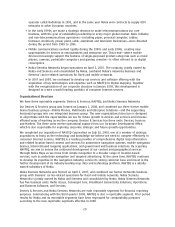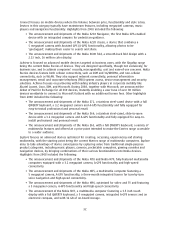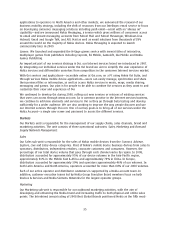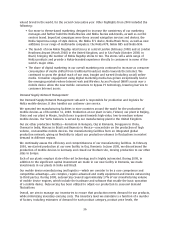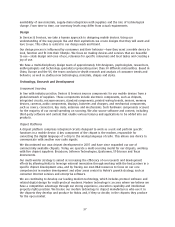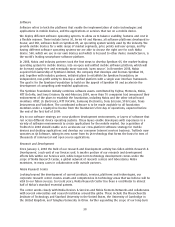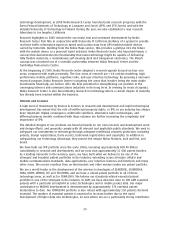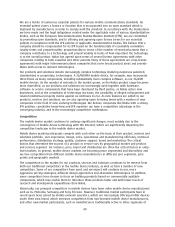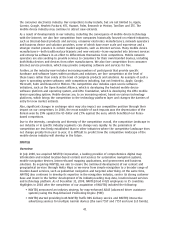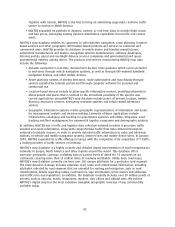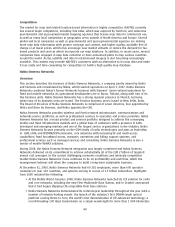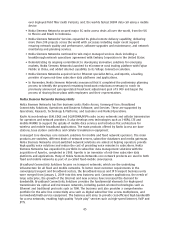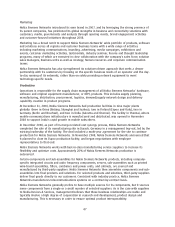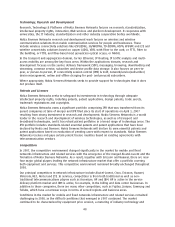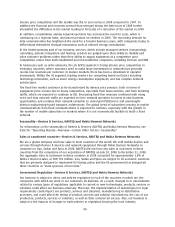Nokia 2008 Annual Report Download - page 40
Download and view the complete annual report
Please find page 40 of the 2008 Nokia annual report below. You can navigate through the pages in the report by either clicking on the pages listed below, or by using the keyword search tool below to find specific information within the annual report.technology development, in 2008 Nokia Research Center launched joint research programs with the
Swiss Federal Institutes of Technology in Lausanne and Zurich (EPFL and ETH Zurich) and with the
Helsinki University of Technology in Finland. During the year, we also established a new research
laboratory in Los Angeles, California.
Research highlights in 2008 included the successful trial and continued development by Nokia
Research Center Palo Alto in conjunction with University of California, Berkeley of a system to provide
realtime traffic information based on speed and location data from GPSenabled mobile devices
carried by motorists. Building from the Nokia Maps service, this provides a glimpse into the future
with the mobile device as a personal travel assistant. Nokia Research Center also launched Morph, a
concept that demonstrates the functionality that nanotechnology might be capable of delivering:
fully flexible materials, a revolutionary selfcleaning shell and transparent electronics. The Morph
concept was conceived out of a scientific partnership between Nokia Research Center and the
Cambridge Nanoscience Centre.
At the beginning of 2009, Nokia Research Center adopted a research agenda focused on four core
areas, compared with eight previously. The four areas of research are: rich context modeling; high
performance mobile platforms; cognitive radio; and user interface technology. By pursuing a narrower
research program, Nokia Research Center is targeting the areas that, besides being the most viable
investments financially, we believe offer the best potential for strengthening our position in the
converging Internet and communications industries in the long term. In revising its research agenda,
Nokia Research Center is also discontinuing research in technology where a certain degree of maturity
has already been reached within the business.
Patents and Licenses
A high level of investment by Devices & Services in research and development and rapid technological
development has meant that the role of intellectual property rights, or IPR, in our industry has always
been important. Digital convergence, multiradio solutions, alternative radio technologies, and
differing business models combined with large volumes are further increasing the complexity and
importance of IPR.
The detailed designs of our products are based primarily on our own research and development work
and design efforts, and generally comply with all relevant and applicable public standards. We seek to
safeguard our investments in technology through adequate intellectual property protection, including
patents, design registrations, trade secrets, trademark registrations and copyrights. In addition to
safeguarding our technology advantage, they protect the unique Nokia features, look and feel, and
brand.
We have built our IPR portfolio since the early 1990s, investing approximately EUR 40 billion
cumulatively in research and development, and we now own approximately 11 000 patent families.
As a leading innovator in the wireless space, we have built what we believe to be one of the
strongest and broadest patent portfolios in the industry, extending across all major cellular and
mobile communications standards, data applications, user interface features and functions and many
other areas. We receive royalties from certain handset and other vendors under our patent portfolio.
We are a world leader in the development of the wireless technologies of GSM/EDGE, 3G/WCDMA,
HSPA, OFDM, WiMAX, LTE and TDSCDMA, and we have a robust patent portfolio in all of those
technology areas, as well as for CDMA2000. We believe our standardsrelated essential patent
portfolio is one of the strongest in the industry. In GSM, we have declared close to 300 GSM essential
patents with a particular stronghold in codec technologies and in mobile packet data. Our major
contribution to WCDMA development is demonstrated by approximately 370 essential patent
declarations to date. Our CDMA2000 portfolio is also robust with approximately 150 patents declared
essential. The number of essential patents is expected to increase further due to the rapid
development of higher data rate technologies, an area where we are a particularly strong contributor.
39


